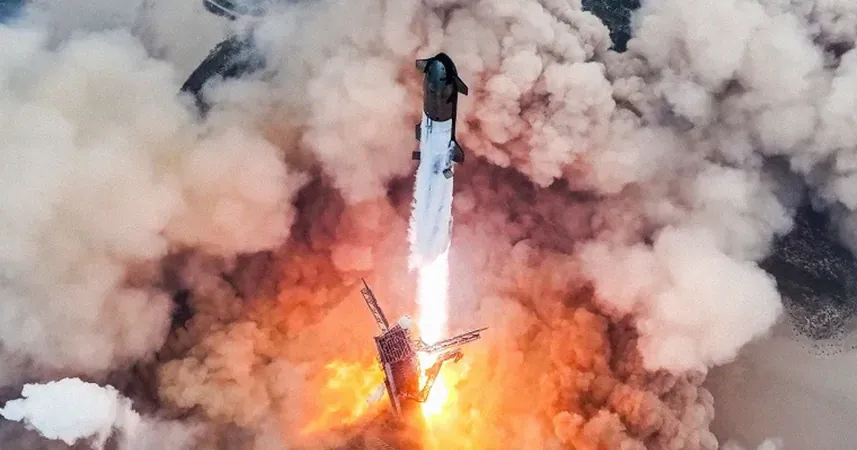
NASA Partners with SpaceX's Starship Despite Track Record of Explosions: What This Means for the Future of Space Exploration!
2025-04-01
Author: Daniel
NASA has officially included SpaceX's Starship rocket in its launch services portfolio, despite the fact that this monumental vehicle has yet to successfully complete a single test flight. The space agency revealed this significant development last week, awarding SpaceX a modification to its existing NASA Launch Services (NLS) II contract, which already includes the well-established Falcon 9 and Falcon Heavy rockets.
These contracts are crucial as they offer a wide range of commercial launch services for NASA’s planetary, Earth-observing, exploration, and scientific missions. However, this announcement raises eyebrows given the ongoing challenges SpaceX has faced with Starship’s upper stage, which has seen multiple test launches end in catastrophic failures—dramatic explosions that have drawn both concern and ridicule from observers.
Elon Musk's influence continues to expand within the U.S. government, creating potential conflicts of interest, particularly as he positions SpaceX within critical roles at NASA. Notably, Jared Isaacman, who is anticipated to become NASA's next administrator, has strong ties to SpaceX, further entrenching the relationship between the two.
The allure of Starship is undeniable; as the largest rocket ever constructed, it holds the potential to revolutionize space access, allowing the U.S. to launch massive payloads into orbit and beyond. This capability extends beyond NASA's exploration endeavors, as the agency can also support other federal entities under the NLS II contract framework.
Despite the promise of Starship, NASA's announcement should not be construed as a strong endorsement. The agency categorizes launch vehicles into risk levels, with Category 1 denoting the highest risk for rockets that have yet to fly. Currently, it remains unclear in which category SpaceX’s Starship will fall. For context, Blue Origin's New Glenn rocket recently achieved Category 1 status – a notable milestone for the company.
NASA's NLS II contracts extend through June 2030, with performance lasting until December 2032. In the interim, SpaceX has sought approval from the Federal Communications Commission (FCC) to communicate with Starship during NASA's Artemis 3 and 4 missions, which are slated for mid-2027 and late 2028. NASA is looking to use Starship to ferry astronauts from lunar orbit to the Moon during its Human Landing System (HLS) program, a critical component of its Artemis missions aimed at returning humans to the lunar surface.
Yet, skepticism looms regarding whether SpaceX can have Starship ready for these historic undertakings. Recent tests have resulted in significant setbacks, as the upper stage of Starship was destroyed during its last launch, littering the Caribbean with debris.
Social media reactions have not held back, with many users humorously critiquing Starship's turbulent development phase. One Reddit user quipped, "Great... I'm sure whenever NASA needs a payload spread across 1000 km of ocean they'll pick Starship," while another added, "It's not so much a delivery system, as it is a distribution system…"
As SpaceX ventures to redefine space travel with its audacious Starship program, the world watches closely—will the testing turmoil give way to triumph, or will the ambitions of Musk's SpaceX succumb to its explosive history? Stay tuned for updates on this thrilling chapter in space exploration!

 Brasil (PT)
Brasil (PT)
 Canada (EN)
Canada (EN)
 Chile (ES)
Chile (ES)
 Česko (CS)
Česko (CS)
 대한민국 (KO)
대한민국 (KO)
 España (ES)
España (ES)
 France (FR)
France (FR)
 Hong Kong (EN)
Hong Kong (EN)
 Italia (IT)
Italia (IT)
 日本 (JA)
日本 (JA)
 Magyarország (HU)
Magyarország (HU)
 Norge (NO)
Norge (NO)
 Polska (PL)
Polska (PL)
 Schweiz (DE)
Schweiz (DE)
 Singapore (EN)
Singapore (EN)
 Sverige (SV)
Sverige (SV)
 Suomi (FI)
Suomi (FI)
 Türkiye (TR)
Türkiye (TR)
 الإمارات العربية المتحدة (AR)
الإمارات العربية المتحدة (AR)